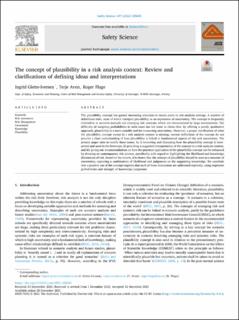| dc.contributor.author | Glette-Iversen, Ingrid | |
| dc.contributor.author | Aven, Terje | |
| dc.contributor.author | Flage, Roger | |
| dc.date.accessioned | 2023-03-15T10:33:41Z | |
| dc.date.available | 2023-03-15T10:33:41Z | |
| dc.date.created | 2022-05-09T11:10:08Z | |
| dc.date.issued | 2022 | |
| dc.identifier.citation | Glette-Iversen, I., Aven, T., & Flage, R. (2022). The concept of plausibility in a risk analysis context: review and clarifications of defining ideas and interpretations. Safety science, 147, 105635. | en_US |
| dc.identifier.issn | 0925-7535 | |
| dc.identifier.uri | https://hdl.handle.net/11250/3058337 | |
| dc.description.abstract | The plausibility concept has gained increasing attention in recent years in risk analysis settings. A number of definitions exist, most of which interpret plausibility as an expression of uncertainty. The concept is frequently referred to in scenario analysis and emerging risk contexts, which are characterized by large uncertainties. The difficulty of assigning probabilities in such cases has led some to claim that, by offering a purely qualitative approach, plausibility is a more suitable tool for measuring uncertainty. However, a proper clarification of what the plausibility concept means in a risk analysis context is missing; current definitions of the concept do not provide a clear understanding of how plausibility is linked to fundamental aspects of risk and uncertainty. The present paper aims to rectify these issues, by i) reviewing and discussing how the plausibility concept is interpreted and used in the literature, ii) providing a suggested interpretation of the concept in a risk analysis context, and iii) giving our recommendations on how the practical application of the plausibility concept can be enhanced by drawing on contemporary risk science, specifically with regard to highlighting the likelihood and knowledge dimensions of risk. Based on the review, it is shown that the concept of plausibility should be seen as a measure of uncertainty capturing a combination of likelihood and judgments on the supporting knowledge. We conclude that a prudent use of the concept requires that each of these dimensions are addressed explicitly, using imprecise probabilities and strength of knowledge judgments. | en_US |
| dc.language.iso | eng | en_US |
| dc.publisher | Elsevier | en_US |
| dc.rights | Navngivelse 4.0 Internasjonal | * |
| dc.rights.uri | http://creativecommons.org/licenses/by/4.0/deed.no | * |
| dc.title | The concept of plausibility in a risk analysis context: Review and clarifications of defining ideas and interpretations | en_US |
| dc.type | Peer reviewed | en_US |
| dc.type | Journal article | en_US |
| dc.description.version | publishedVersion | en_US |
| dc.rights.holder | The authors | en_US |
| dc.subject.nsi | VDP::Samfunnsvitenskap: 200 | en_US |
| dc.source.volume | 147 | en_US |
| dc.source.journal | Safety Science | en_US |
| dc.identifier.doi | 10.1016/j.ssci.2021.105635 | |
| dc.identifier.cristin | 2022592 | |
| cristin.ispublished | true | |
| cristin.fulltext | original | |
| cristin.qualitycode | 2 | |

